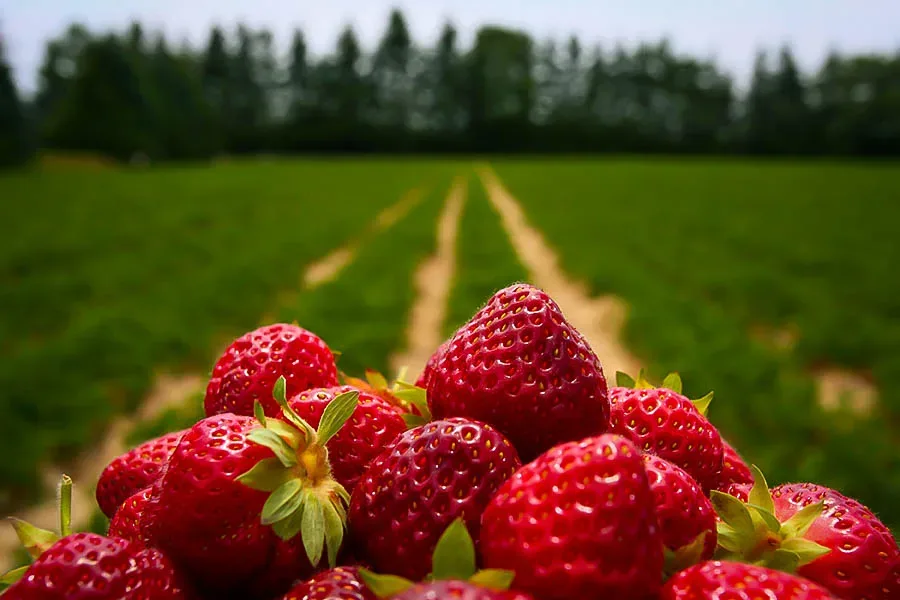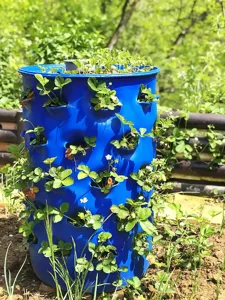
Written by s • How To Grow Strawberries
Of all the berry fruits, strawberries are certainly the most popular and the most versatile. Fresh, with cream, in shortcake, or in jams and preserves, they have so many uses and we never seem to tire of eating them. So it is lucky that they are also one of the easiest fruits to grown in the home garden, and they crop heavily too, so your efforts will pay dividends. Not only can they be grown in the garden, but there are several ways of growing them well in pots too, if you don’t have the space in your garden for a strawberry bed.
Basic Strawberry Plant Care
The basic needs for strawberry growing are a sunny location with well-drained soil, with some organic material in it. Sun is important, all day long is best and shade will cause a decline in your harvest. Since this is a mounding plant that grows on the ground, not a bush, some protection from the fruit touching the soil is also helpful. The traditional material is straw (Ah, so that is why they are called straw-berries!) but modern growers usually cover their beds with landscape fabric, which also keeps weeds down.
In spring, as the new growth begins to sprout, some high-nitrogen fertilizer will help improve your crop. This can be an organic fertilizer like seaweed emulsion or something inorganic, like a liquid fertilizer for fruit bushes, or for vegetables like tomato plants
Remove any weeds and only water early in the morning on sunny days, especially during flowering and fruiting, to reduce diseases that may rot the fruit. At the end of the season, as the leaves start to yellow, cut them right off, to keep the plants healthy and stop them rotting in the winter. In colder areas you may need to put straw over the rows to protect them from cold.
Plant a Strawberry Patch
The full, top-rung way of growing plants is to divide your area into three parts. The total size will depend on how much room you have and how many plants you want to grow. For the first year, cover the area with landscape fabric and cut x-shaped holes at the right spacing and plant through the fabric. Start by planting the first third only with young plants, you can plant some vegetables in the other areas until they are needed.
Space your plants 18 inches apart in rows 3 feet apart. This may seem like a lot of room, but plants get large and need the space to spread out. These plants will produce a crop of berries in the first summer after you plant them. That first crop will be large berries, but not a huge quantity. In the second summer after planting the plants will be much bigger and give an enormous crop, but the berries will be a bit smaller. In the third year you will get a big crop of smaller berries – ideal for jam-making. As soon as you harvest that third crop, dig up and discard the plants and dig over the bed, adding lots of compost or manure to re-enrich the soil.
In that first year, after the plants have produced their first crop, they will send out ‘runners’ – long stems that produce small plants on their ends. Let some of these root in the ground (some people put small pots under them instead) and then in the early fall of that year transplant them into the second section of your bed. The next season plant the third section with new plants from runners and you now have the whole system set up. After each section has produced three crops, dig those plants up and plant new plants from those runners in the section. Once set up you will always have a section giving large eating berries, another giving medium-sized ones and a third giving smaller fruit for preserves. Your yield will be large and your plants will always be vigorous.
Strawberries in Planters and Pots
If you don’t want a full-scale strawberry patch, strawberries can be grown in several other ways. At the simplest end of the scale, just put a plant or two into a sunny part of your garden beds. You will get a nice crop for several years and enjoy home-grown fruit. Another possibility is to put your plants into pots or planter boxes and grow them on a balcony or terrace. The plants are pretty in leaf, in flower and in fruit, and the fruit will stay clean because it will hang outside the pot. You can also buy ‘strawberry pots’. These are tall clay or plastic pots with holes in the sides, which take several plants in each pot and give you much more fruit for the space taken up than an ordinary pot will do.
Build a Strawberry Barrel
Another way to grow a large number of plants in a smaller space is to take an old wooden whiskey barrel and cut holes into the sides. If you can’t find a full wooden barrel at your local lumber yard or garden centre, you can join two half-barrels together or use a plastic rain-barrel.
Drill a few holes in the bottom for drainage, the make holes about 3 inches across, square or round, space about 15 inches apart around the barrel, in several rows, starting near the bottom. Stagger the holes in each row so that they are not directly above each other. The exact number and position will depend on the style of your barrel and where the hoops are, but allow about 12 inches between each row if you can.
Now start filling the barrel with outdoor potting soil. When you reach the first row of holes, place a plant in each hole with the crown at the hole and the leaves hanging out. Keep adding more soil and more plants till you reach the top. You can put about three plants on the top too, but leave at least two inches free at the top so that when you water you can really flood your barrel with lots of water and let it drain right through the soil so all the plants get well-watered. Place the barrel in a sunny spot – you will get a big yield for several years.
For just a little work getting set up, strawberry plants are among the easiest of berry bushes to grow and the yield of beautiful, garden-ripened, flavor-full and super-fresh fruit will amaze you. Good luck with your berries!






